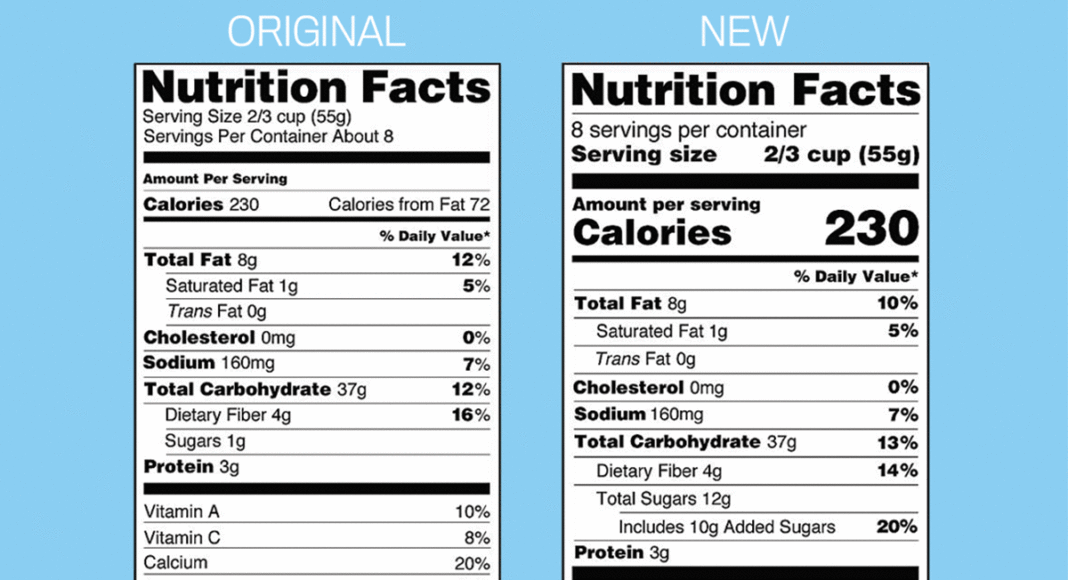Grabbing a bag of chips to pair with my sandwich the other day, I couldn’t help but notice the calorie count printed on the package. Being somewhat of a nutrition nerd already, I was used to reading food labels, but this felt different. Instead of me looking for the nutrition facts, it seemed the nutrition facts were actually looking for me.
It turns out that I’m not going crazy (about this, anyway), as the FDA recently changed the standard layout of the nutrition facts food label for the first time in more than 20 years. Given the constantly evolving nature of nutrition recommendations, that food labels haven’t changed in more than two decades is kind of shocking in itself. But in May of last year, the FDA announced the new label, and currently all food manufacturers with annual sales over $10 million must have them on their packaged food by July, 2018. Many food companies have already made the switch, and the new labels are becoming more and more ubiquitous.
Although the changes aren’t drastic—most obviously, the bolding and increase in font size of the calorie count—there are nonetheless some significant differences that reflect scientific findings and highlight new guidelines. And I won’t be the only one noticing them: a 2014 FDA survey found that 77 percent of adults reported using the nutrition facts labels always, most of the time, or sometimes when buying a food product. But if information isn’t clearly listed, or is confusing or misleading, the average consumer has no shot at being adequately informed.
In addition to the emphasized calorie count, serving sizes—which were previously often arbitrary and unrealistic—have also changed.
“By law, serving sizes must be based on amounts of food and beverages that people are actually eating, not what they should be eating,” says the FDA on its website. They hope the new label closes this loophole, and products that are typically consumed in one sitting must also provide nutrition information about the entire container.
Total fat, saturated fat, and trans fat are all still required on the new label, but interestingly, the “calories from fat” information is being removed. Why? “Because research shows the type of fat is more important than the amount,” says the FDA’s website. This isn’t exactly revelatory, but the FDA acknowledging that not all calories are created equal pokes a major hole in the already besieged and increasingly archaic “a calorie is a calorie is a calorie” school of thought.
One addition to the new label that is probably not going down well with many food manufacturers is that the total “added sugars” must now be listed. The amount of hidden sugar in many foods is much higher than consumers might often suspect, so the new label seeks to pull this curtain back.
And when it comes to vitamins and minerals, it’s clear that scientific data points to many Americans being deficient in vitamin D, calcium, iron, and potassium. The amounts and “percent daily value” of these micronutrients are now required to be listed. And speaking of percent daily value, the footnote at the bottom of the label will now better explain the concept.
But even with new and more informative food labels, it is still important to read the ingredients list, too, because it’s crucial to know what is actually in your food. One good thing to know when reading those ingredients is that they are listed in descending order by weight, so the first ingredient will be the one that weighs the most, and so on. This helps consumers avoid unhealthy ingredients that appear early on the list. Some nutritional landmines to watch out for include sugar, high-fructose corn syrup, non-whole grain flour, and unhealthy fats like margarine or any type of hydrogenated oil. The process of hydrogenation is what produces artificial trans fat, which is extremely unhealthy and tends to lower good cholesterol, increase bad cholesterol, and contribute significantly to the development of coronary heart disease. For this reason, the FDA is seeking to completely eliminate it from processed foods by banning the ingredient starting in 2018. But for now, it’s still around, and it’s also important to know that if a food has less than 0.5g of trans fat per serving, then the food can be labeled as “trans fat-free” even though it has partially hydrogenated oils.














I am hosting a new documentary about Homeopathy called “Just One Drop” at the Nickelodeon Theatre on monday November 13 at 7:30pm. After the movie there will be a Q&A and panel discussion with two local doctors and professional homeopath. It’s a crowd sourced movie through Gathr so we need to get people to reserve their tickets in advance. gathr.us/s/21269
Being a homeopathic practitioner for the past 17 years I’ve helped many people with this potent form of natural medicine.
I’d like to meet with you so we could do an article about homeopathy and this important new film.
thank you, Will Cassilly 477-7782